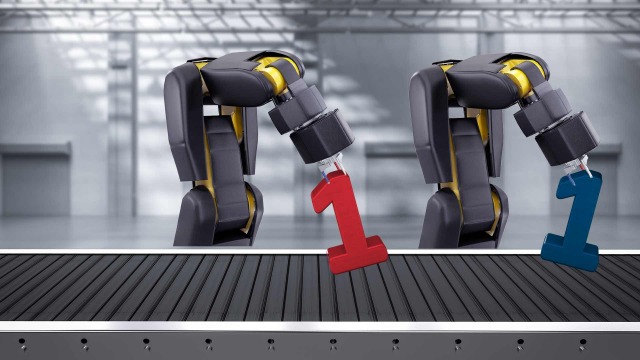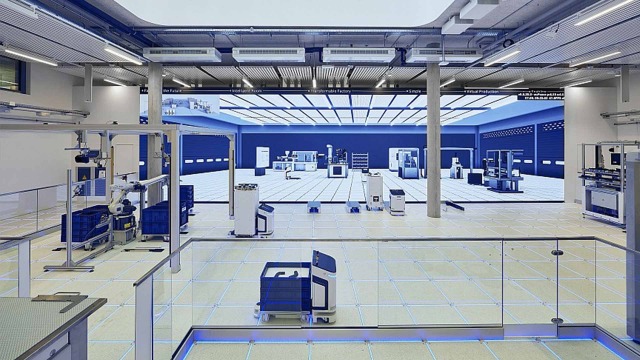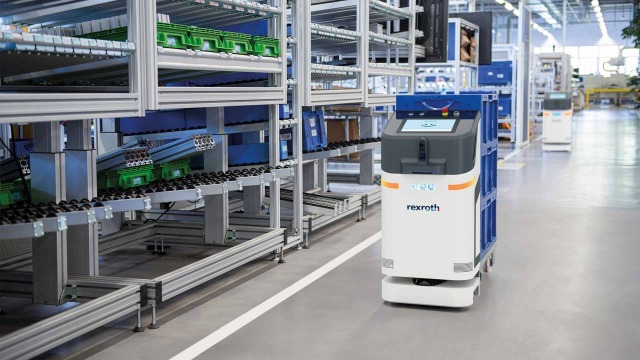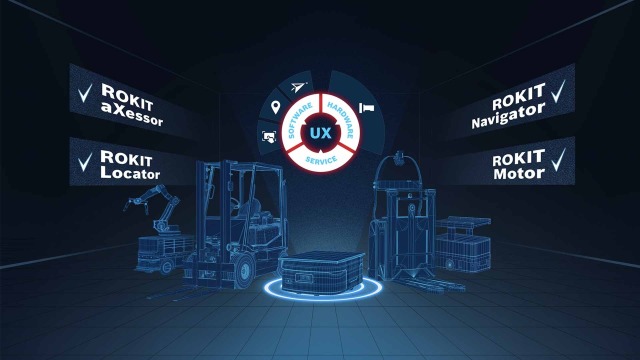

Select your location
Bosch Rexroth around the world
Asia & Pacific
Europe


In a world where customers increasingly want customized products and demand volatility is a continuous issue, flexibility is becoming increasingly important to the manufacturing industry. Fortunately, there is a solution that gives you this level of flexibility – and it comes in the form of robotics.
With demand volatility and the increasing requirement for greater product variation, comes challenges and opportunities. Those who can meet this demand stand to gain significant competitive advantage. In fact, a recent report by the International Federation of Robotics listed ‘Batch size 1 and customized product variations’ as one of the most important current market trends.
Our vision of the Factory of the Future offers complete flexibility and variability enabling you to meet these complex requirements. And one of the ways we do this is with robotics. Working side-by-side with people, robotics solutions will complement the human workforce, while control remains firmly in human hands.

Not only can these flexible robotics solutions be easily integrated into your existing factory infrastructure, they can enable the economical production of small batch sizes, even batch size 1. With the help of a digital twin, the process can be optimized to make it as effective and efficient as possible.
No longer limited to a single production process, mobile assistance systems can be flexibly used for different purposes. They can be moved to different areas and adapted quickly according to requirements. Our family of APAS robots can handle batch sizes as small as batch size 1, while also dealing with peak loads flexibly and economically. Designed to work together with people and machines without the need for a safety enclosure, they can be integrated safely and easily into factories.

Autonomous Mobile Robots (AMRs) and Automated Guided Vehicles (AGVs) are an essential part of the flexible factory, delivering components on demand from a central store to an assembly point on the production line. In a recent report, the International Federation of Robotics included ‘AMRs and delivery robots’ in their current top 5 service robotics application trends.
Our AMR, the recently enhanced ActiveShuttle, finds its way around the factory safely and independently. Thanks to camera-based 3D obstacle detection, it avoids obstacles and happily works alongside people and other machines. The integrated touchscreen allows for individual configuration and quick intervention on site, while the control software enables fleets to be managed easily and flexibly.

With demand for mobile robots increasing, OEMs need flexible solutions that can be used in a wide range of vehicle types and applications to maximize their efficiency and productivity. That’s where ROKIT – the robotics kit by Bosch Rexroth, comes in. ROKIT consists of four elements: ROKIT aXessor is an intuitive graphical user interface for the central access to all ROKIT components; ROKIT Locator maps the environment and determines the position and orientation of the vehicles (based on SLAM – simultaneous localization and mapping); ROKIT Navigator is easy-to-integrate navigation software that enables you to control the movement of goods from A to B; ROKIT Motor is an all-in-one, ready-to-use wheel drive module for mobile robots.

We spoke to Jörg Heckel, Director of Mobile Industrial Robotics at Bosch Rexroth, to find out how ROKIT – the robotics kit by Bosch Rexroth was developed and why it will make AMRs and AGVs an even more fundamental part of the Factory of the Future.

When did you realize there was a requirement for this type of product range and what drove that need?

Bosch has a long history of robotics research. In 2014 the Bosch team finalized a comprehensive study and decided to set up a corporate start-up. It was clear by 2017 that there was a strong customer need for this type of robotics solution, so we started work on the industrialization of the range here at Bosch Rexroth.

How does ROKIT help to meet the need for smaller batch sizes and multi-variant products?

The components are modular, so ROKIT is a very flexible solution and it can be used in different applications. It’s also very easy to use and reduces complexity, so it saves time and makes the process more efficient, while also offering greater precision and quality.

How do you go about developing a new innovation like ROKIT – what’s the process or your way of working?

We work in interdisciplinary, agile teams. One of the things that’s special about Bosch Rexroth – especially for a large corporation – is that we have flat hierarchies, which encourages people to contribute ideas and trust their team members. We also work closely with customers while we’re developing new products. And we focus on software to help speed up the innovation process and deliver more value to customers and end-users in shorter intervals.

How long did it take to develop ROKIT?

It took us a little over a year to bring the first release to market. But it’s the acceleration of the deployment time for new releases that’s been really beneficial to our customers. The first release took us two or three months – I don’t mean the feature development but everything around it like quality assurance or documentation. Now we’ve got the release time for a major release down to just a week, while a minor release takes us less than a day without sacrificing any quality.

Can you tell us about the team that developed ROKIT and their roles?

ROKIT is a family of components, so the teams work in parallel to build the portfolio. A few dozen people work on the portfolio and the job roles include research, quality and testing, business development, marketing, sales and service.

What did you enjoy most about working on this project?

The feedback from the amazed customers when they tried it for themselves and discovered how easily and quickly they can get the localization of the ROKIT Locator working. And, of course, working with such committed teams.

What do you think is the most important customer benefit of ROKIT?

In general, it’s about saving time and effort when building and installing new AGVs and AMRs. Small and medium enterprises (SMEs) are getting access to scarce software engineering power.

Can you tell us anything about what you’ll be working on next?

One of the things we’re looking into is the interconnection of mobile platforms with factory and warehouse automation equipment. This will involve modular architectures, exciting useability and automated application procedures. So watch this space!

Jörg Heckel